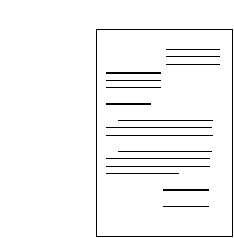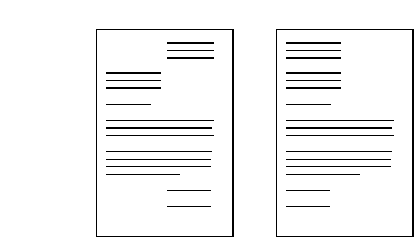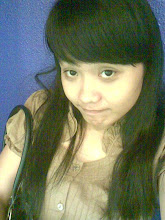
Elements Business letters (in the United States) usually contain the following elements, in order: - Sender's address & contact information
- Date of writing
- Recipient's name, title, company, & address
- salutation/greeting
- Subject
- Message (body of the letter)
- Valediction/closing
- Sender's signature
- Sender's name, title, company
In some situations, a business letter may also include the following optional information: - Enclosures (Encl.: or Enc.:)
- Recipients (cc:)
- Reference Initials (of the typist, if different from original author of letter)
Line Spacing In general, each element or paragraph of the letter is followed by a single blank line, except: - the date, followed by three or four blank lines;
- the final content paragraph, followed by two blank lines;
- the valediction/closing, followed by three or four blank lines (enough for the sender to sign the letter); and
- the sender's title, followed by two blank lines.
| Sample Business Letters |  | Full Block Business Letter Components This sample includes the formal components of full block business letters. Some of these components are optional for typical, employment-related business letters. You may download or copy samples, examples or templates of employment-related business letters, by clicking on the links below. |

Legend: -
Return Address: If your stationery has a letterhead, skip this. Otherwise, type your name, address and optionally, phone number. These days, it's common to also include an email address. -
Date: Type the date of your letter two to six lines below the letterhead. Three are standard. If there is no letterhead, type it where shown. -
Reference Line: If the recipient specifically requests information, such as a job reference or invoice number, type it on one or two lines, immediately below the Date (2). If you're replying to a letter, refer to it here. For example, - Re: Job # 625-01
- Re: Your letter dated 1/1/200x.
-
Special Mailing Notations: Type in all uppercase characters, if appropriate. Examples include - SPECIAL DELIVERY
- CERTIFIED MAIL
- AIRMAIL
-
On-Arrival Notations: Type in all uppercase characters, if appropriate. You might want to include a notation on private correspondence, such as a resignation letter. Include the same on the envelope. Examples are -
Inside Address: Type the name and address of the person and/or company to whom you're sending the letter, three to eight lines below the last component you typed. Four lines are standard. If you type an Attention Line (7), skip the person's name here. Do the same on the envelope. -
Attention Line: Type the name of the person to whom you're sending the letter. If you type the person's name in the Inside Address (6), skip this. Do the same on the envelope.. -
Salutation: Type the recipient's name here. Type Mr. or Ms. [Last Name] to show respect, but don't guess spelling or gender. Some common salutations are - Ladies:
- Gentlemen:
- Dear Sir:
- Dear Sir or Madam:
- Dear [Full Name]:
- To Whom it May Concern:
-
Subject Line: Type the gist of your letter in all uppercase characters, either flush left or centered. Be concise on one line. If you type a Reference Line (3), consider if you really need this line. While it's not really necessary for most employment-related letters, examples are below. - SUBJECT: RESIGNATION
- LETTER OF REFERENCE
- JOB INQUIRY
-
Body: Type two spaces between sentences. Keep it brief and to the point. -
Complimentary Close: What you type here depends on the tone and degree of formality. For example, - Respectfully yours (very formal)
- Sincerely (typical, less formal)
- Very truly yours (polite, neutral)
- Cordially yours (friendly, informal)
-
Signature Block: Leave four blank lines after the Complimentary Close (11) to sign your name. Sign your name exactly as you type it below your signature. Title is optional depending on relevancy and degree of formality. Examples are - John Doe, Manager
- P. Smith
Director, Technical Support - R. T. Jones - Sr. Field Engineer
-
Identification Initials: If someone typed the letter for you, he or she would typically include three of your initials in all uppercase characters, then two of his or hers in all lowercase characters. If you typed your own letter, just skip it since your name is already in the Signature Block (12). Common styles are below. -
Enclosure Notation: This line tells the reader to look in the envelope for more. Type the singular for only one enclosure, plural for more. If you don't enclose anything, skip it. Common styles are below. - Enclosure
- Enclosures: 3
- Enclosures (3)
-
cc: Stands for courtesy copies (formerly carbon copies). List the names of people to whom you distribute copies, in alphabetical order. If addresses would be useful to the recipient of the letter, include them. If you don't copy your letter to anyone, skip it. Tips: -
Replace the text in brackets [ ] with the component indicated. Don't type the brackets. -
Try to keep your letters to one page, but see page 2 of this sample if you need continuation pages. -
How many blank lines you add between lines that require more than one, depends on how much space is available on the page. -
The same goes for margins. One and one-half inch (108 points) for short letters and one inch (72 points) for longer letters are standard. If there is a letterhead, its position determines the top margin on page 1. -
If you don't type one of the more formal components, don't leave space for them. For example, if you don't type the Reference Line (3), Special Mailing Notations (4) and On-Arrival Notations (5), type the Inside Address (6) four lines below the Date (2).
Simplified Style
Simplified Style is a form letter similar to the Straight shape fully but it’s just that without any greeting and closing greetings. Usually this letter in addressed to the people who were working in the company. Sometimes a simple form of letter writing is very simple without the need to look at tidiness and order. Parts of the letter of the Simplified Style : 1. Letterhead 2. The date of the letter 3. Letter No. 4. Attachment 5. Concerning 6. The letter is aimed at 7. A word of salutation 8. Body of the text 1. Introduction letter 2. Explanation of the contents of the letter 3. Closing the letter 9. Closing Greetings 10. Name of office 11. Signature 12. Who signed the name 13. Carbon copy 14. Page appendix letter / Initials
|







0 komentar:
Posting Komentar